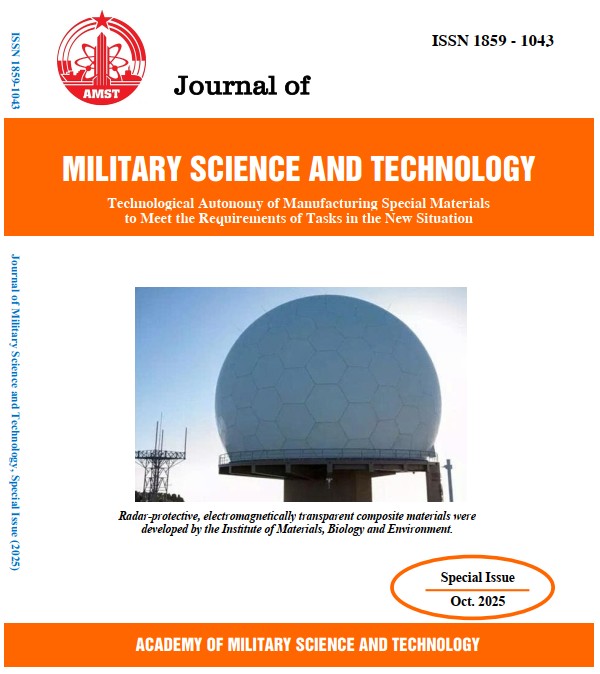Nghiên cứu ứng dụng công nghệ quang Peroxone để xử lý nước thải chứa TNT phát sinh từ quá trình xì tháo bom mìn, vật nổ
DOI:
https://doi.org/10.54939/1859-1043.j.mst.IMBE.2025.136-143Từ khóa:
TNT; Quang Peroxone; Bom mìn; Đạn nổ cấp 5; AOPs.Tóm tắt
Nước thải phát sinh từ quá trình xì tháo bom mìn, vật nổ, đạn dược cấp 5 có độ màu lớn, chứa hàm lượng cao 2,4,6-Trinitrotoluen (TNT) và các hợp chất khác là thành phần của các loại thuốc phóng, thuốc nổ. Đây là loại nước thải có tính độc hại cao, bền vững với môi trường và rất khó xử lý bằng các phương pháp thông thường. Bài báo này trình bày kết quả nghiên cứu xử lý nước thải xì tháo bom mìn, vật nổ trên cơ sở phản ứng quang Peroxone. Một số yếu tố ảnh hưởng đến hiệu quả xử lý như: pH, nồng độ H2O2, cường độ bức xạ UV, thời gian và lưu lượng tuần hoàn đã được nghiên cứu. Kết quả cho thấy, hiệu quả xử lý tỉ lệ thuận với nồng độ H2O2, cường độ bức xạ UV, lưu lượng nước tuần hoàn và hầu như không bị ảnh hưởng bởi pH ban đầu của nước thải. Tại nồng độ H2O2 = 40 mmol/L, cường độ bức xạ UV = 3,0 W/L, lưu lượng tuần hoàn = 0,6 lần/phút, sau 120 phút xử lý, hiệu quả xử lý TNT giảm 96% (từ 12,88 mg/L giảm còn 0,52 mg/L) và độ màu giảm 93% (giảm từ 1.115 Pt-Co xuống còn 78 Pt-Co) đạt QCVN 40:2025/BTNMT và TCVN/QS 658:2011 mức B.
Tài liệu tham khảo
[1]. Pham Son Tung et al., "Treatment of TNT contained water using UV-Fenton process", Journal of Military Science and Technology, 82, 98–104, (2022). https://doi.org/10.54939/1859-1043.j.mst.82.2022.98-104.
[2]. Nguyen D. K. D., Nguyen D. Tan, and Hoang K. Hue, "Study on the characteristics of TNT decomposition reaction using Peroxone oxidant under conditions without and with UV irradiation", Journal of Chemical, Physical and Biological Analysis, 20, (2015).
[3]. Van Nguyen H. et al., "Effective treatment of 2,4,6-trinitrotoluene from aqueous media using a sono–photo-Fenton-like process with a zero-valent iron nanoparticle (nZVI) catalyst", RSC Advances, 14, 23720–23729, (2024). https://doi.org/10.1039/d4ra03907f.
[4]. Nguyen Van Hoang et al., "2,4-Dinitrotoluene (DNT) Removal Efficiency Using the Sono-Photo-Fenton Process Combined with Nano Zero Valent Iron (nZVI) Heterogeneous Catalysis", VNU Journal of Science: Earth and Environmental Sciences, 40, 149–158, (2024). https://doi.org/10.25073/2588-1094/vnuees.5195.
[5]. Krzywicka A. K.-K., "The comparison of efficiency of Fenton and photo-Fenton treatment of stabilized landfill leachate", Environmental Protection and Natural Resources, 26(3), 49–53, (2015). https://doi.org/10.1515/oszn-2015-0020.
[6]. Nguyen Manh Khai et al., "Study on Removal of Styphnic Acid in Aquatic Environment by using UV-H₂O₂/nano TiO₂", VNU Journal of Science: Earth and Environmental Sciences, 34, 98–103, (2018). https://doi.org/10.25073/2588-1094/vnuees.43139.
[7]. Miranzadeh M. R. et al., "Evaluation of Efficacy of Advanced Oxidation Processes Fenton, Fenton-like and Photo-Fenton for Removal of Phenol from Aqueous Solutions", Journal of Chemical Society of Pakistan, 37, 266–271, (2015).
[8]. Clarizia L., Di Somma D., Marotta R., and Andreozzi R., "Homogeneous photo-Fenton processes at near neutral pH: a review", Applied Catalysis B: Environmental, 209, 358–379, (2017). https://doi.org/10.1016/j.apcatb.2017.03.011.
[9]. Babuponnusami A. and Muthukumar K., "A review on Fenton and improvements to the Fenton process for wastewater treatment", Journal of Environmental Chemical Engineering, 2, 557–572, (2014). https://doi.org/10.1016/j.jece.2013.10.011.
[10]. Nguyen Van Huong et al., "Application of Response Surface Methodology to Optimize Mononitrotoluene Aquatic Removal by Photo-Fenton Process", VNU Journal of Science: Earth and Environmental Sciences, 40, 66–73, (2024). https://doi.org/10.25073/2588-1094/vnuees.5192.
[11]. Nguyen Dinh Hung et al., "Nghiên cứu ứng dụng công nghệ quang Fenton để xử lý nước thải phát sinh từ quá trình xì tháo bom mìn, vật nổ", Journal of Military Science and Technology, Special Issue of Scientific conference for graduate students and young researchers, 144–151, (2021) (in Vietnamese).







